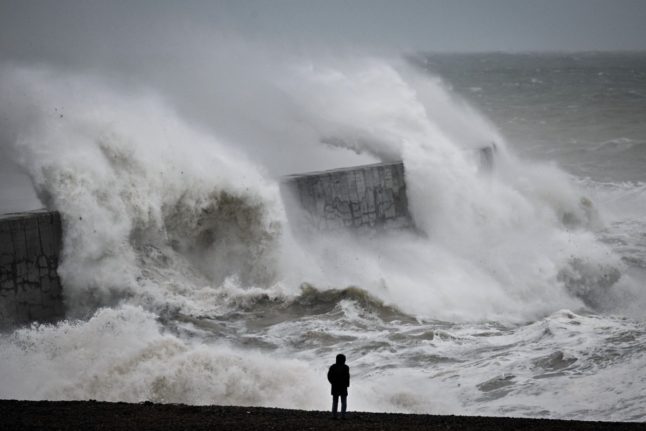It’s not just the UK and other parts of Western Europe that have been feeling the wrath of Storm Ciarán this Thursday, Spain has been battered by rains and gale-force winds too, causing chaos across the country.
Forty-eight of Spain’s 50 provinces (with the Canary Islands being the exception) have been placed on alert and the storm has already caused widespread chaos in many regions.
In Madrid, a tree fell on the A2 motorway causing three kilometres of traffic jams.
Police in the Spanish capital have also confirmed the death of a young woman in the Alonso Martínez neighbourhood after a tree fell on her and injured three others.
Madrid firefighters attended 109 emergency calls on Thursday morning due to problems related to the strong winds and falling tree branches on the streets.
🚨 #ÚLTIMAHORA | Una mujer de 23 años ha muerto este jueves por la caída de un árbol en el número 2 de la calle Almagro de Madrid
El árbol ha caído por los fuertes vientos que ha dejado el paso de la borrasca Ciarán. También hay otros tres heridos leves. pic.twitter.com/umUeb0MR1T
— EL ESPAÑOL (@elespanolcom) November 2, 2023
Railway operator Adif has suspended circulation on several railway lines across the country and set speed limits on others due to strong lateral wind gusts higher than 100 kilometres per hour.
Firefighters from Huesca have rescued three people and their pets from two cabins in Pyrenean village of Castiello de Jaca, due to flooding and intense rains.
Storm Ciarán has caused power cuts in the northwestern region of Galicia as well, with some 9,800 customers affected.
Ser reportero no está pagado #Ciarán pic.twitter.com/ZhJfpgUaGl
— Natalia Álvarez (@Natalia_Who) November 2, 2023
The ski resort of La Pinilla, in the province of Segovia, experienced the strongest wind gusts in the country so far this morning at 151 kilometres per hour, the State Meteorological Agency (Aemet) reported.
Strong winds also forced the cancellation of 13 flights from Bilbao airport. During the course of the morning, flights to or from Seville, London, Barcelona, Porto, Frankfurt, Madrid, Amsterdam and Munich stopped taking off or landing.
🌀 La borrasca Ciarán provoca la cancelación de 18 vuelos en Madrid, Bilbao, Asturias, Vigo, La Coruña y Santander, y numerosas incidencias en los servicios ferroviarios de Galicia, Asturias, Cantabria y el País Vasco.
Toda España, salvo Canarias, sigue en alerta. pic.twitter.com/ryALD4dif2
— EFEnoticias España (@EFEnoticias_ES) November 2, 2023
Falling branches and trees, along with the accumulation of water have forced the cancellation of several flights from Santiago de Compostela airport too.
‼️ Duna-exprés en Riazor para frenar las olas de Ciarán pic.twitter.com/Api5Cxjch8
— La Voz de A Coruña (@vozcoruna) October 31, 2023
The storm has left a trail of incidents in Galicia including 168 km/h winds in the mountains of Lugo, intense rainfall of more than 70 litres per square meter near Pontevedra and waves of almost seven metres in La Coruña. Train services have been suspended since November 1st between Ourense and Vigo and between La Coruña and Ferrol.
🌀Llega lo peor de la borrasca 'Ciarán': barrerá España con vientos de 100 km/h e intensas nevadas
La primera borrasca de la semana impactará con especial fuerza este jueves en España dejando temporales marítimos y lluvias.
🎥Así ha entrado por Galicia pic.twitter.com/h1tKW9gnr1
— EL ESPAÑOL (@elespanolcom) November 2, 2023
Storm Ciarán has been making its way up through Europe, also affecting much of France, the UK and the Netherlands.
The storm battered northern France with record winds of nearly 200 km/h, causing a lorry driver to be crushed by a falling tree and some 1.2 million French homes to lose electricity overnight.
In Cornwall in southern England, large waves powered by winds of 135 km/h, crashed along the coastline on Thursday morning, while hundreds of schools across the region were closed.
On the Channel Island of Jersey, residents had to be evacuated to hotels overnight as wind gusts of up to 164 km/hour damaged homes, according to local media.
And, the Netherlands also warned of powerful gusts of up to 100 km/h, with workers told to avoid commuting and 206 flights marked as ‘cancelled’ at Amsterdam’s Schiphol Airport, a major European hub.



 Please whitelist us to continue reading.
Please whitelist us to continue reading.
Member comments